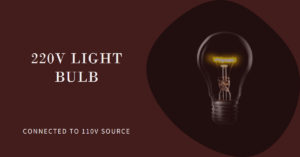Understanding the compatibility between voltage levels is crucial when it comes to using electrical appliances.
In various parts of the world, different voltage standards are in place, with 220V and 110V being the most common.
This article aims to explore the potential risks and consequences of connecting a 110V appliance to a 220V power source. Yes, connecting a 110V appliance to a 220V power source can potentially harm the appliance and pose safety hazards.
Understanding Voltage
What is Voltage?
Voltage, measured in volts (V), is the electrical potential difference between two points in a circuit. It determines the flow of electric current and is a key factor in operating electrical devices.
Common Household Voltage Standards
Different countries adopt different voltage standards for their electrical grids. In the United States, the standard voltage is typically 110V, while in many other countries, including most of Europe, Asia, and Africa, the standard voltage is 220V.
The Difference Between 220V and 110V
The main distinction between 220V and 110V lies in the magnitude of the voltage. 220V systems have higher voltage levels compared to 110V systems. This difference in voltage has significant implications for electrical appliances designed to operate within specific voltage ranges.
The Impact of Voltage on Appliances
Voltage Ratings of Appliances
Electrical appliances are manufactured with specific voltage ratings, usually indicated on the appliance itself or in the user manual. It is essential to understand the voltage requirements of an appliance before plugging it into a power source.
Compatibility Issues with Different Voltage Levels
When an appliance is designed to operate on 110V, connecting it directly to a 220V power source can lead to compatibility issues. The appliance may not function properly or may experience significant damage due to the excessive voltage.
Consequences of Using the Wrong Voltage
Using a 220V power source with a 110V appliance can have several adverse effects. These include electrical overload, heating and insulation problems, component damage, and safety hazards.
It is crucial to avoid such situations to ensure the longevity and safety of appliances.
Can 220V Harm a 110V Appliance?
Electrical Overload
Connecting a 110V appliance to a 220V power source can cause an electrical overload. The higher voltage can lead to excessive current flow through the appliance, potentially damaging its internal circuitry.
Heating and Insulation Problems
The increased voltage can cause excessive heat buildup within the appliance. Components not designed to handle this higher voltage may overheat, potentially leading to insulation failure, melting of wires, or even fire hazards.
Component Damage
Voltage-sensitive components within the appliance, such as capacitors, transformers, and integrated circuits, may not withstand higher voltage levels.
This can result in irreversible damage to these components, rendering the appliance inoperable.
Safety Hazards
Using the wrong voltage can create safety hazards, such as electric shocks, short circuits, or even electrocution. It is essential to prioritize safety and adhere to voltage requirements to avoid such risks.
Protective Measures
Voltage Conversion Techniques
In certain situations where compatibility is required, voltage conversion techniques can be employed.
These techniques involve modifying the incoming voltage to match the requirements of the appliance. However, they should be implemented with caution and preferably by a qualified electrician.
Using Voltage Adapters or Transformers
Voltage adapters or transformers can be used to bridge the gap between different voltage levels.
These devices convert the incoming voltage to a suitable level for the appliance, ensuring proper operation and minimizing the risk of damage.
Seeking Professional Assistance
If unsure about voltage requirements or how to handle a specific appliance, it is always advisable to seek professional assistance from an electrician or the manufacturer. They can provide guidance and ensure that the appliance is used safely and correctly.
Precautions and Safety Guidelines
Reading Appliance Labels and Specifications
Before using any electrical appliance, carefully read the labels and specifications provided by the manufacturer.
Pay close attention to the required voltage range to ensure compatibility with the available power source.
Double-checking Voltage Requirements
When traveling or relocating to regions with different voltage standards, double-check the voltage requirements of your appliances.
This will help you determine whether voltage adapters or transformers are necessary for safe operation.
Traveling and International Voltage Considerations
When traveling internationally, it is crucial to be aware of the voltage standards in the destination country.
Using appliances designed for a specific voltage level without appropriate adapters or transformers can lead to serious damage.
Conclusion
Connecting a 110V appliance to a 220V power source can have severe consequences, potentially damaging the appliance, causing safety hazards, and compromising its functionality.
It is essential to understand the voltage requirements of electrical appliances and ensure compatibility with the power source to prevent such issues.
Prioritizing safety and seeking professional guidance when necessary can help avoid costly damage and protect both the appliances and individuals using them.

